Staying Dry and Stylish: Understanding Rain Gear and Outerwear Garment Categories
Posted by Anthony Webb on Nov 26th 2024
MCR Safety began manufacturing rain gear during the 1980s under the company name of River City. Founded in 1983, River City merged with two other companies, Memphis Gloves and Crews Glasses, to create MCR Safety in 2004.
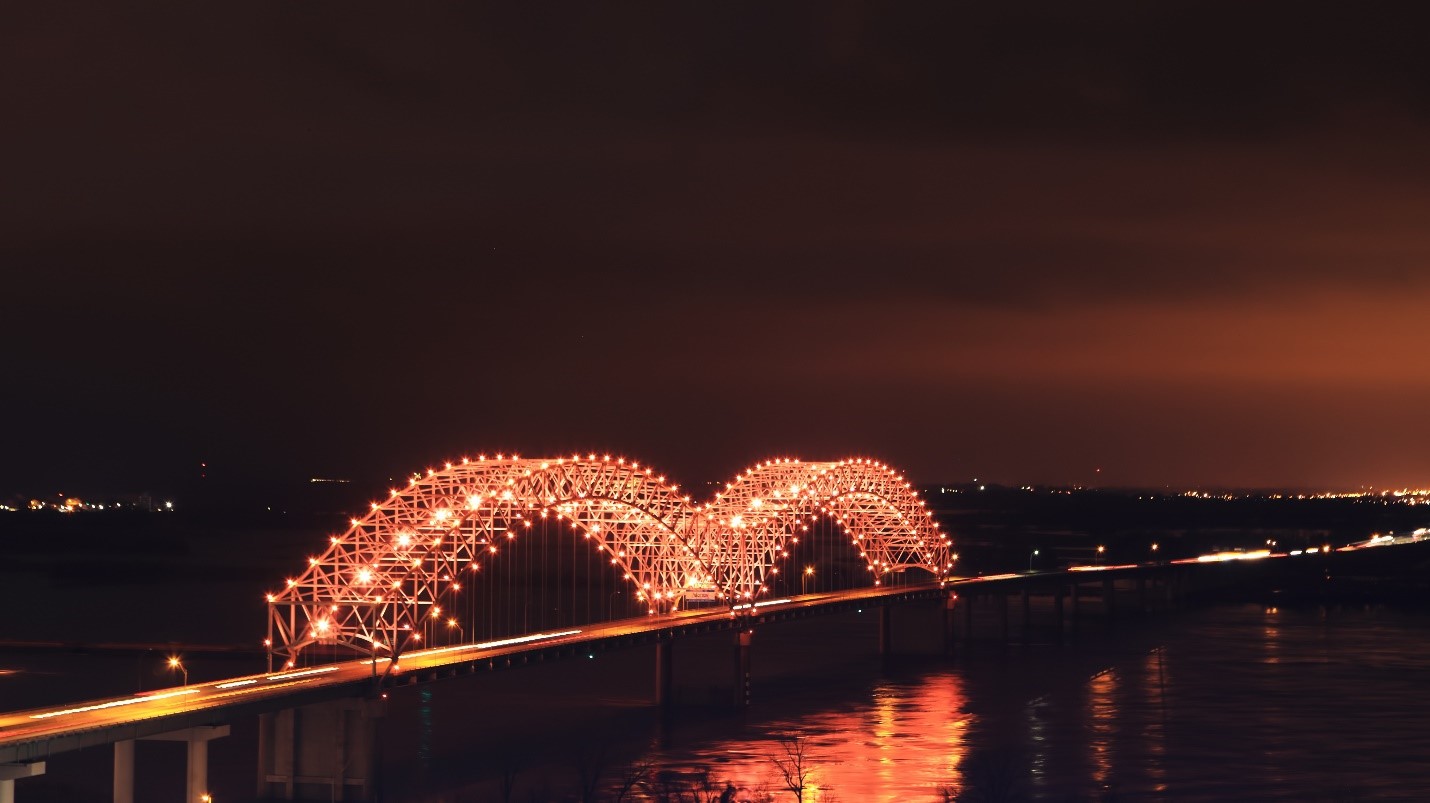
Memphis, a river city known for AutoZone, the Bass Pro Shops at the Pyramid, Elvis, FedEx, Rendezvous barbecue, The Cotton Museum, International Paper, the University of Memphis, Memphis Tigers basketball, Grizzlies basketball, and MCR Safety, which makes top-quality rain gear
We're set apart from our competitors by having one of the broadest raingear lines in the industrial market. We cater to wearers seeking high-end designs, mid-tier options, and competitively priced styles. In contrast, most industrial personal protective equipment (PPE) companies only stock one or two tiers, and MCR Safety stocks all three! Our product line ranges from styles designed for chemical resistance to those offering warmth to high-visibility options. You'll find rain gear offered as single-use ponchos, high-end breathable jackets, and stretchable options that let you move freely so you can still get the job done. Most importantly, our rain gear is designed to keep you dry, allowing you to stay comfortable and protected in the elements.
Nobody enjoys becoming drenched by rain, especially when it's cold outside. This article highlights the different coatings available on our rainwear and then jumps directly into the specific raingear categories. Read on to learn more and let's get you out of the rain, or at least protected from it! !
Commercial, Industrial, Safety, and Sports

MCR Safety caters primarily to those needing work rain gear; however, our products are also worn across many facets of everyday life. Rain gear is a type of protection everyone needs, whether you're headed out into nature camping, adventuring on the boat, or riding a motorcycle. Here are some more leisure activities people may need rain gear for:
- ATV Riding
- Backpacking
- Biking
- Cycling
- Golf
- Fishing
- Hiking
- Hunting
- Running
In commercial and industrial work settings, anyone riding to work in the rain always needs protection. In addition, rain gear is often used by those employed in agriculture, airports, carpenters, commercial fishing, construction, EMS, forestry, food processing, logging, long-haul driving, mining, oil and gas, police, sailors, theme parks, and utilities. Rain gear for tree work is one area that relies heavily upon work rain gear, as it always involves unpredictable weather. Essentially, safety work rain gear is worn across numerous industries and occupations. And, as you learn in our Best Work Rain Gear Features article, those in southern states must always have their rain gear nearby.

MCR Safety's highest quality rain gear, the UT38JH rain jacket, breathes, flexes, and comes with enhanced zippers and sealing.
And MCR Safety rain gear offers enhanced protection from more than just rain. Those involved in chemical processing can also use our rain gear to protect them from numerous industrial chemicals.
Waterproof Basics
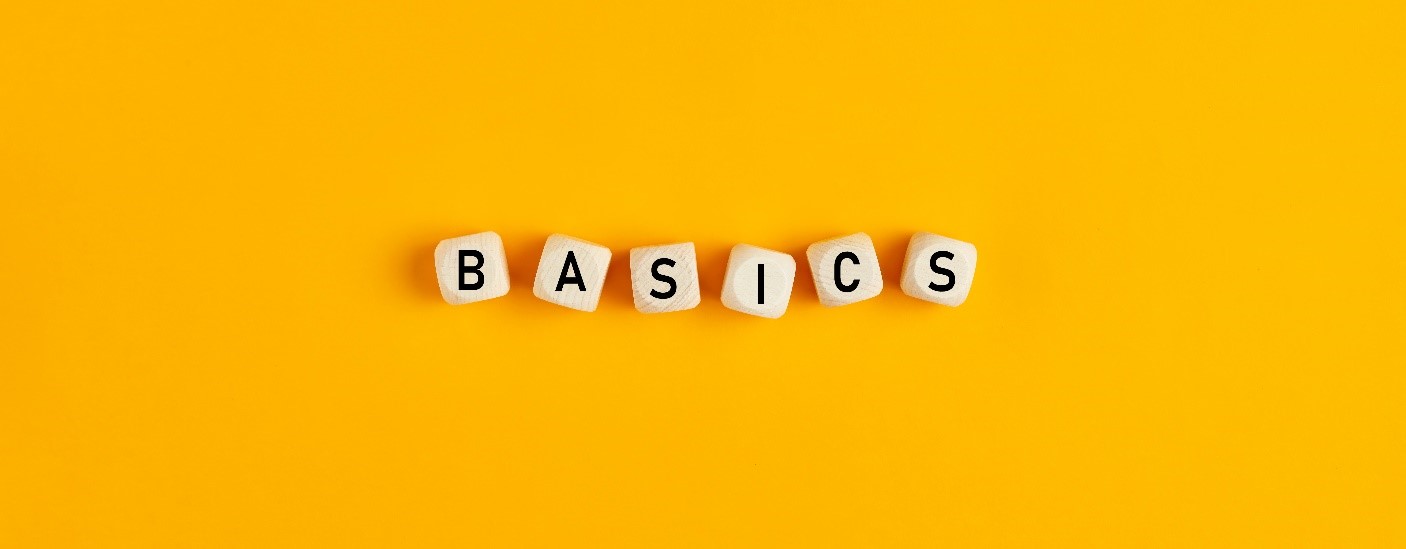
What is rainwear? The short answer is that it's a waterproof or water-resistant garment. A rain jacket or another piece of clothing is considered "waterproof" when its water resistance is high enough to repel a driving rain. While the exact testing standard and qualifications can be debated, waterproof gear keeps you dry even when it's pouring.
Within MCR Safety's product lineup, any product with a PVC coating will be waterproof. This might include a poncho, coat, or suit. However, items tested to ASTM F903 offer the most significant waterproof protection, as they're designed to hold up against specific chemicals as well and can protect wearers from liquid splash hazards.
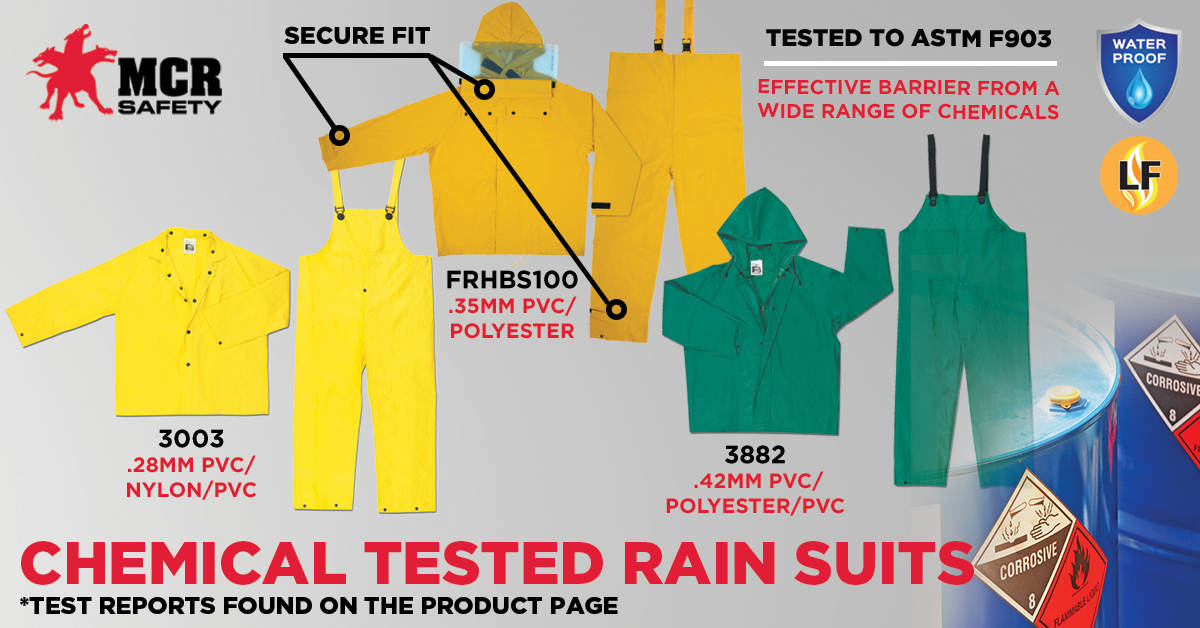
The ASTM F903 test method provides users insight into a garment's liquid penetration performance.
While waterproof raingear can help protect from the elements, it can become hot or cumbersome as it doesn't breathe well. On the other hand, water-resistant gear can cope with light rain over a brief time and provide better breathability. Water-resistant gear can be overwhelmed in torrential or sustained heavy rain and winds. However, it would be best to balance the waterproof protection you need with the overall quality, cost, and comfort level you expect. This is why MCR Safety offers such a wide range of options: it all comes down to the different qualities offered in different garments.
Top Rated Materials and Polymers
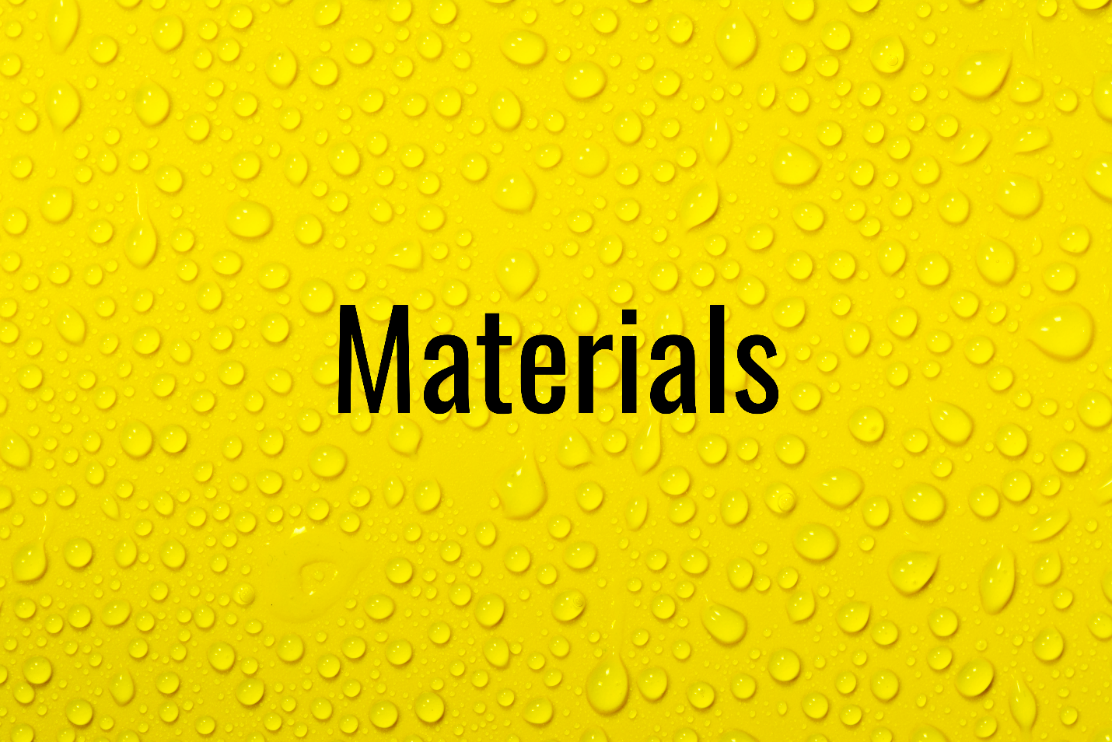
Most rain gear looks similar, but not all are created equal. Rain gear can be made using various coatings and materials, allowing for different quality levels, features, and applications. It's important to know what to expect from each.
The most crucial part of any rain attire is knowing the coating used on the garment. Below is a breakdown of the polymer coatings used in MCR Safety's rain gear.
Polyvinyl Chloride
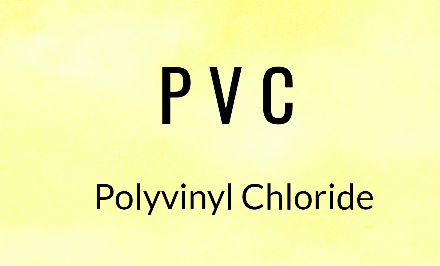
You are probably familiar with PVC rainwear, even if you don't recognize it by name. PVC is often thought of as the classic fisherman's yellow rainwear. It's the most recognized polymer used for manufacturing raingear. Since it's a robust and versatile polymer, it provides good overall waterproof performance. PVC, often called "vinyl," affords less breathability, however. Most of our mid-tier options feature PVC.
Polyurethane

PU, or polyurethane-coated rain gear, provides the wearer with a thinner, more stretchable material designed to be more lightweight and comfortable. Don't let the comfort fool you; it's still highly durable, and most of our high-end styles feature a PU coating.
Wearing PU is also advantageous because it doesn't look or feel like plastic.
Neoprene
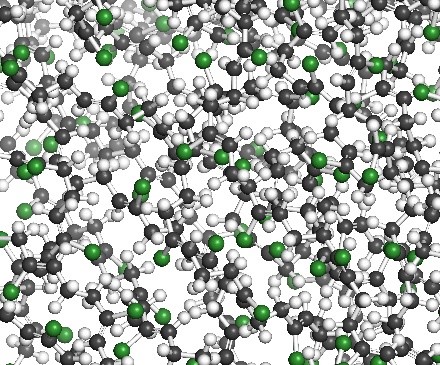
Created by DuPont® scientists, the neoprene polymer is a synthetic rubber known for toughness, flexibility, and the ability to remain adaptable over various temperatures. Neoprene is resilient, offering better abrasion and puncture resistance than PVC, and when combined with a nylon backing, it makes it one of MCR Safety's most durable rain protection offerings. The added abrasion-resistant qualities are excellent for holding up against the scuffs and scratches from rough working job sites.
Most wet suits are neoprene, demonstrating this polymer's toughness for making rain gear. Our best chemical-resistant and durable option features a neoprene coating and is discussed more in our heavy-duty section.
Polyethylene
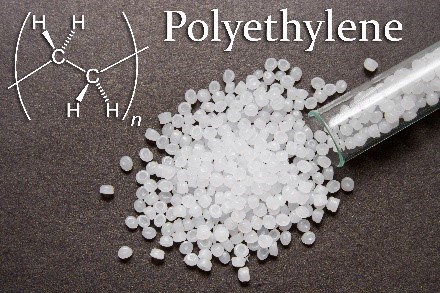
A thermoplastic material that is widely used for temporary protection, specifically within our ponchos.
Regarding the thickness of our polymer coatings, the most common weight found across our rain gear lineup is .35mm. However, some poncho styles come in at .02mm, and some thicker styles reach .50 mm. Most of the finished coatings are eventually bound and laminated to a backing, a fabric that provides comfort and support. Knitted stretch polyester, polyester, and nylon are three of the most common backings
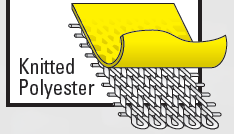
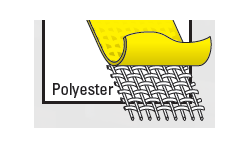
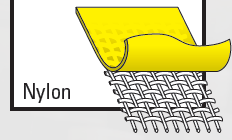
MCR Safety's Rain Gear Categories

We want our users to be able to quickly locate the different rain gear options we offer. Here is a list of MCR Safety's rainwear lineup:
Let's explore each of these.
Coats
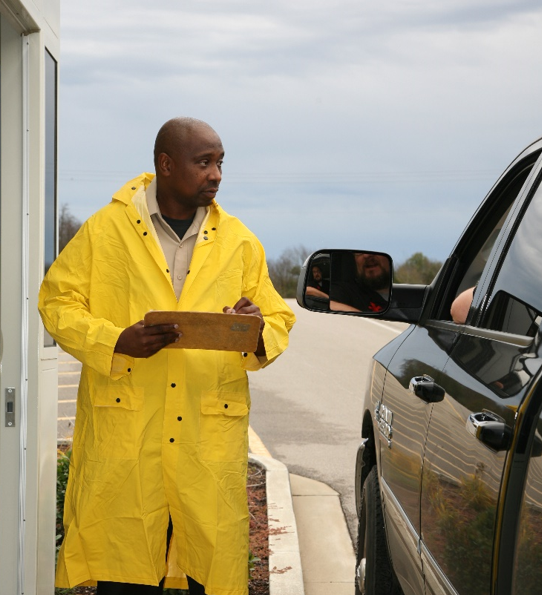
The longer-length material in this rain gear keeps workers dry without wearing a full rain suit. We carry a variety of coats in different materials, including neoprene, PU, and PVC.

Rider coats are a popular option in the oil and gas industry.
The most common raincoat style is the 49" coat with a detachable hood. This extended length protects the knee area. Generally, it eliminates the need for protective pants. Other coats include an attached hood, no hood, or an extended 60" version.
Whenever you need additional protection over the legs, you'll choose a coat over the category we discuss next.
Jackets

What is a rainwear jacket? Like the top-selling 200C above, rain jackets keep water off the wearer's top portion. Those with a full polymer coating on the outside are waterproof, whereas some are water-resistant, like the insulated styles we discuss next.
MCR Safety's rain jackets are approximately 30" long and, on average, come just below the waist. Many jacket styles are available, including detachable or attached hoods, protecting your head from falling rain. A part number that ends in "J" reflects a detachable hood on our rain gear guide, and a "JH" reflects an attached hood.
Insulated Jackets

In the thick of winter, workers need a hi-vis bomber jacket to insulate them from the biting cold. But cold days can also bring wet conditions, so waterproof options are necessary. As we highlight in our Winter Work Jackets article, tens of thousands of workers require this type of protection each winter.
We offer two different types of insulated jackets:
- Bomber – fits tightly at the waist and fastens with a zipper.
- Parka - a hip-length jacket, primarily made with heavy liners for cold weather

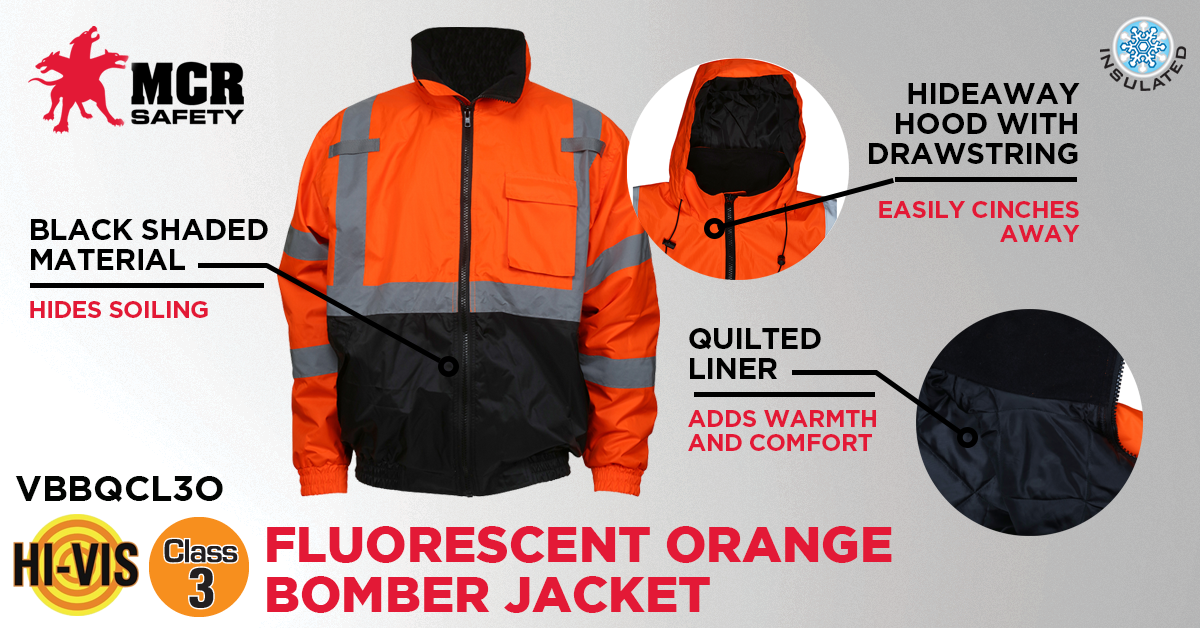
We now stock an orange insulated bomber jacket, too!
2-in-1 insulated jackets combine a rain jacket with a removable insulated shell, usually made of fleece or cotton. The outer layer of an insulated jacket is generally nylon or polyester, while the inner layer protects against water and provides comfort and warmth.
Rain Suits
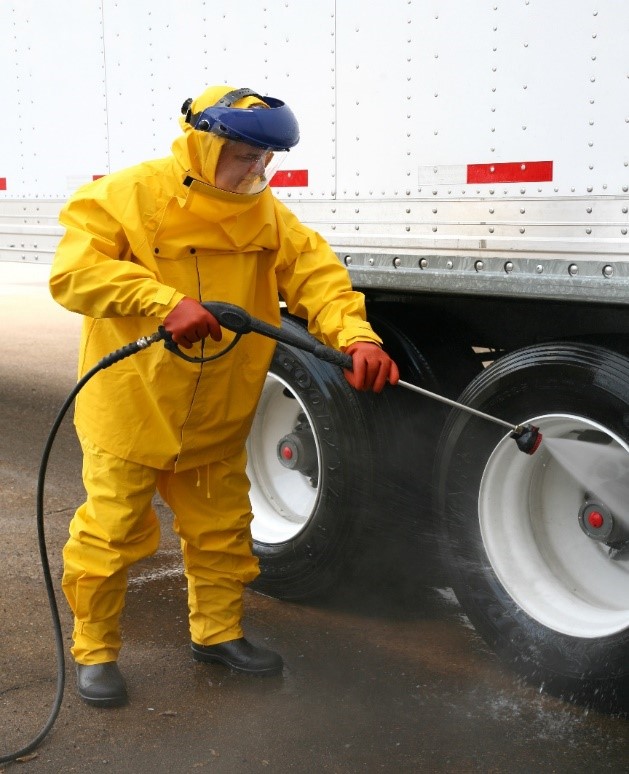
A multi-piece rain suit usually consists of a waterproof jacket and pants. The jacket shields the upper frame, and the pants protect the lower part of the body. Rain suits help keep clothing protected and can help you stay dry when working outside for extended periods. The Hydroblast series, shown above, provides Velcro closure points at the ankles, neck, and wrists, further ensuring the wearer stays dry.
Let's explore the two main configurations in rain suits: the three-piece and the two-piece.
Three-Piece Suits

The most popular rainwear configuration is the three-piece suit with a jacket, detachable hood, and bib overalls or waist pants. As a rule of thumb, if the fourth digit of the style number is a "3," the garment is a three-piece suit. Examples include 2003 and 3003, shown below.

The Classic 2003 Series, shown above, is the most popular option across almost all industries. It combines PVC's strength and waterproof qualities with the durability of a polyester backing. It also doesn't hurt that it's offered at a mid-tier price point option.
Two-Piece Suits
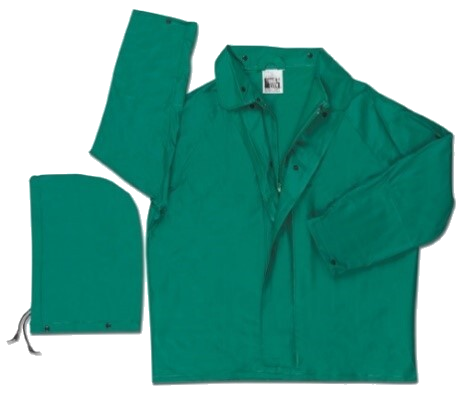
This version of a rain suit has a jacket with a permanently attached hood and bib overall or waist pants. Generally, if the fourth digit in the style number is a "2," it is a two-piece suit. Examples include 3902 and 3882.

Most people see the color green, and they know that typically means it's a 3882 chemical-resistant suit.
Whenever you want complete protection from the rain, a suit's multiple pieces work together to protect your entire body.
Pants

Bib pants, shown above, are the most popular rain pants. These styles feature more coverage above the waist, protecting the chest from liquids. Suspenders are used to fasten the back to the front securely.
Elastic waist pants protect your legs, and do not rely on suspenders for support. They also complement any safety vests worn by increasing the reflective material on one's body.

Most rain pants are made from premium PU to stand up against the beating lower legs endure on most job sites.
Packable Ponchos
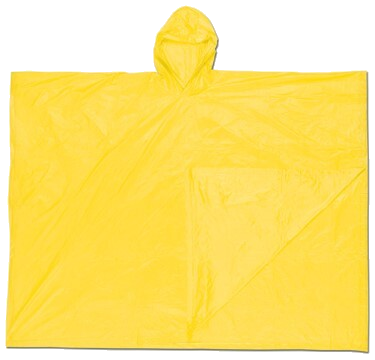
Like the top-selling 040 shown above, ponchos are sleeveless garments with a slit or hole in the middle so that they can be slipped over the head. They often come in disposable forms, which are recommended for only a short time.
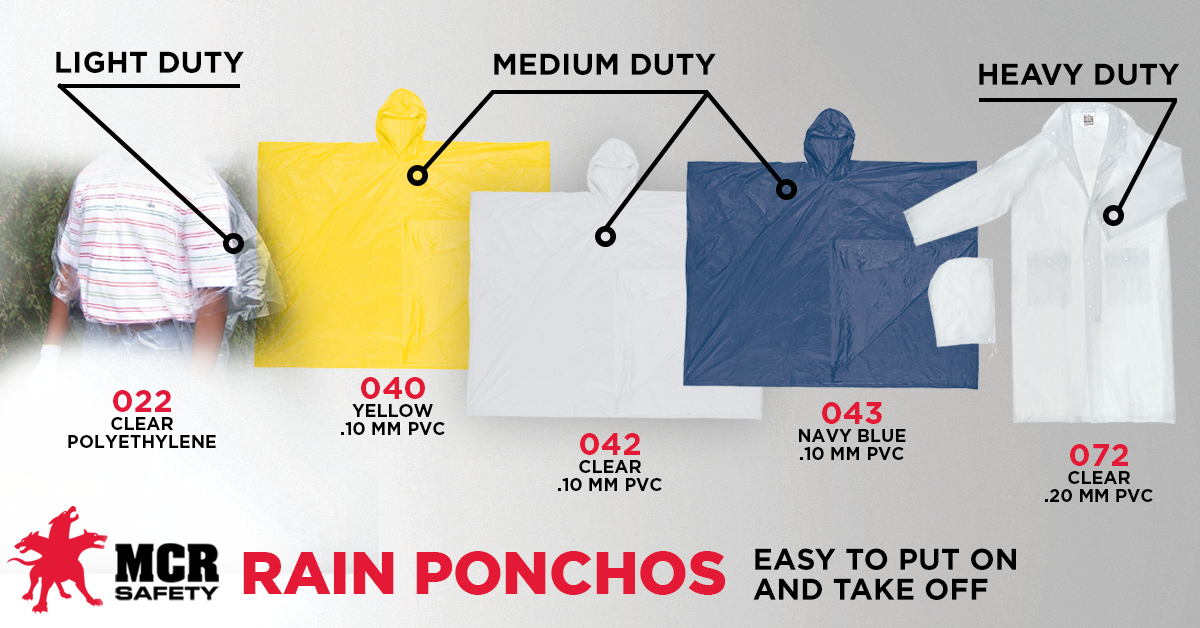
MCR Safety's ponchos come in light-, medium-, and heavy-duty options.
Ponchos provide significant body coverage since they're a sizeable layered garment with much surface area. However, they're less effective and more challenging to use in windy conditions. Without arm fittings, ponchos can more easily be hurled around by the wind, exposing the body. Still, capes can make for compelling, waterproof armor that provides much coverage for the body in calmer conditions.
Ponchos are also quick and easy to put on and remove. Also, they're an excellent option for traveling in and out during a rainstorm. Putting on a rain suit each time, by comparison, would take much too long!
Click the above features image to check out our core Work Rain Gear Features article, or click here.
You can look at all the qualities and features in our article titled The Best Work Rain Gear Features. There we examine all the specifics that set each garment apart within each of our categories. Within each category mentioned above, specific features set each garment apart. We've created a separate article explaining each core feature best: breathability, heavy-duty qualities, hi-vis, stretch and flexibility, and lightweight offerings.
Common Questions

What is the best rain gear for working outside?
- It depends. Those working in warmer weather should consider breathable options, those in winter conditions need to be insulated, and those needing long-term wear and tear should consider neoprene styles.
What brand makes the best rain gear?
- With 40 years of rain gear manufacturing experience, MCR Safety is one of the most well-known and trusted brands. We're continuously adding new features and garment configurations, a sign of a thriving company dedicated to improving the user's experience.
Who sells rain gear?
- All of our products can be purchased via one of our industrial distribution partners. For immediate trials, visit our Buy and Try site.
Keeping Water at Bay When Outdoors and You Dry
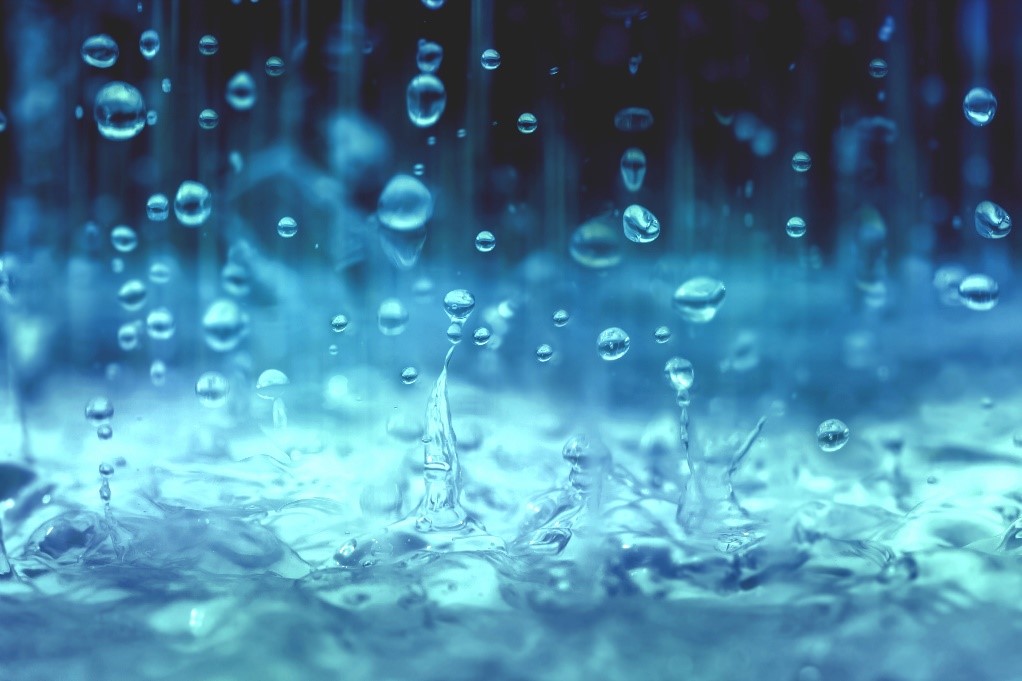
When you need to keep water off your body, wear rain gear. We hope we've accomplished what we set out to do: give you the information you need to be highly knowledgeable in this area.
As mentioned above, if you need more insight into the specific features of different options within each category, we recommend visiting our Work Rain Gear Features article. Simply click the icon below.

Click the below image to leave us comments, questions, or any concerns.
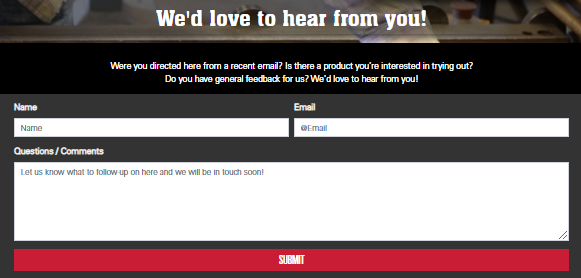
For over 45 years, MCR Safety has proven to be a world leader in gloves, glasses, and garments. Whether it's handling parts with nylon gloves, assembling products with polyester PU gloves, or working at a construction site, we are there, providing solutions to workplace hazards. It's all part of our commitment to protect people.
No matter your industry, we have the personal protective equipment you need.
Click the above image to be taken directly to our PPE online catalog.
Learn more about MCR Safety by checking out our most recent video. For more information, browse our website, request a catalog, find a distributor, or give us a call at 800-955-6887.

